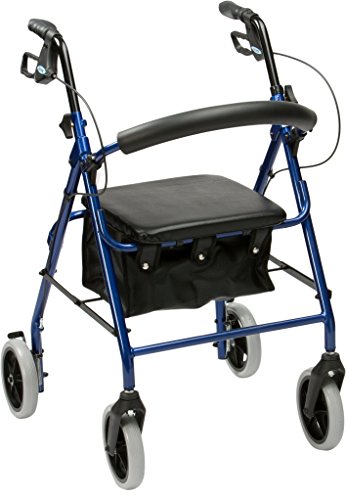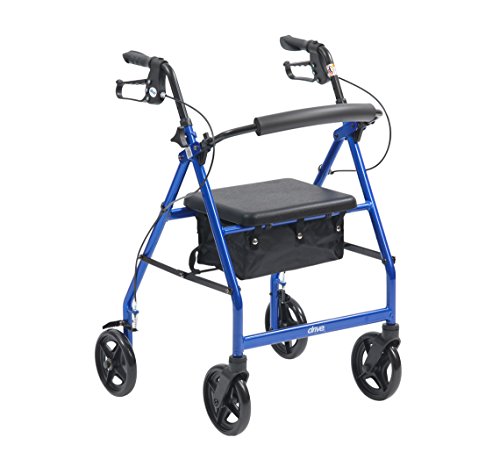Rollator Seat Enhances Comfort and Convenience
 A rollator seat offers an ideal resting spot during walks or excursions. These unique mobility aids let seniors continue to enjoy the beautiful sights and the events they enjoy without worrying about fatigue or discomfort.
A rollator seat offers an ideal resting spot during walks or excursions. These unique mobility aids let seniors continue to enjoy the beautiful sights and the events they enjoy without worrying about fatigue or discomfort.
Start by determining the height of your handle to determine the correct rollator. Take a measurement of the distance from your hips to the floor, then add one or two inches.
Comfortable Seating
Many rollators come with an integrated seat, providing users a place to sit and relax while taking walks or resting. They can be folded up when not in use, and are usually padded for comfort. Some come with storage options, such as bags and baskets to store personal items, food items or medical equipment.
When selecting the best rollator walker with seat rollator with a seating option be sure to take into account the preferences and requirements of the user. The first thing to consider is height of the seat to floor, which needs to be in line with the measurements of the user. To determine this the person should sit in their normal shoes, with their elbows bent slightly and their arms to their side. Then, record the distance from the floor to the middle of their wrist. This is the handle's height.
Then, ensure that the seat depth will support your thighs when you are sitting upright. Choose a model that has an adjustable backrest that can support all of your spine. This design distributes the weight evenly across the seat, reducing stress on muscles and joints.
Curved backrests are crucial to ensure proper spinal support. The lower five lumbar vertebrae make up the concave curve of small of the back and are attached to the sacrum, a large triangular bone that lies at the base of the pelvis. The twelve thoracic spines that form a convex curve in the middle of your back, are situated above these. In addition, seven cervical vertebrae form the neck.
While a backrest that is curved can be an extra expense however, it's worth the investment to improve both comfort and functionality. The extra support provided by a chair that is curved can also help users maintain a proper posture when seated. This could reduce the stress on their shoulders or back.
When looking for a roll-on walker, make sure to consider the frame size and seat size. This will ensure that it can fit through doorways and passageways. You should also check whether there are any replacement parts available in case your unit is damaged beyond repair. The manufacturer usually provides hyperlinks on their website to purchase the parts.
Adjustable Seat-to-Floor Height
Adjusting the seat's height is vital to ensure stability, reducing fatigue in the thighs, and promoting good posture. The height of the seat is measured from the back to the popliteal fossa or the kneecap of the person. The user may require a lower height of the seat relative to the floor to get an appropriate foot strike while self-propelling, or due to reasons of posture. For instance to maintain the hips in neutral position during transfers or to support a larger trunk angle in order to correct postural imbalances.
Bariatric models are available to those who use rollators and require an elevated seat to floor height. They offer a bigger seating area and can hold up to 500 pounds. These models are typically wider than standard four-wheel rollators, and have a reinforced frame with large, high-quality wheels to handle heavier user weight.
The seating style is also crucial. Padded seats are softer and more comfortable than unpadded plastic, which can become uncomfortable and hot after long use. The padded and contoured seating is typically more expensive than seating that is not padded. However, the added price can be worth it in terms of comfort and durability.
If a client's range of motion is limited, a padded seat or a contoured chair that raises the person to a more upright posture is more for them. This will help ease the strain on their hips as well as knees while walking, and permit them to engage in MRADLs with no needing caregiver assistance.
Before you purchase, it is a good idea for you to test the rollator's seating height in a retail store or even at home. The potential buyer should sit in the chair with their feet flat on the floor and take off their shoes. Keep their elbows slightly bent and their arms to the sides. To determine the ideal handle height take a measurement from the wrist center to the ground.
For optimal performance, it's essential that the seat height and handle height match up. If the seat is set to the ideal height and the handles are in a comfortable length, the user can rest more comfortably and reduce strain on their muscles and joints. When determining if a product is able to navigate obstacles, it's crucial to consider the dimensions of the doors and passageways that are frequently used.
Storage Pouches or Baskets
Rollator seats can be equipped with storage bags and baskets that allow users to carry their personal belongings or medical equipment during longer trips. These items are usually placed underneath the seat, and secured with the strap or flap that can be shut and opened. Some models feature a wire or mesh basket and others include a tray that keeps the bag securely in place. Some tray models are able to be removed for cleaning, which makes it easier to keep the interior clean.
Many people make use of accessories to improve the functionality and ease-of-use of their rollator. A cup holder attachment removes the requirement to hold drinks with your hands, and a food tray is a convenient way to store food and snacks on the go. Many manufacturers offer a variety of attachments that are compatible with their particular models.
We liked the Hugo Mobility Explore model because it comes with a large under-seat storage bag for accessories, as well as a clever folding mechanism. It's among the lightest models we've test, and its large 8-inch wheels that are all-terrain make it an ideal option for outdoor use, as well. Panelists were impressed by the fact that the rollator could be folded down to a compact size to make it easy to transport in a vehicle or public transport.
When purchasing a rollator, buyers should take into consideration the frame's material as well as its weight capacity and its color. A frame made of aluminum is lightweight and provides stability and mobility and steel frames provide an additional level of strength for users weighing of up to 250lbs. Some models also come with bariatric or heavy-duty rollators, which have a higher weight capacity and are wider than normal models to accommodate larger users. Some models also have a cushioned seat, which helps reduce pressure points and ease pain from conditions like sciatica or arthritis.
Accessories
Accessories for the Rollator can transform the mobility aid into a tool that meets the specific needs of each user. Soft cushions for seats, adjustable heights from the floor to the seat, as well as storage pouches or baskets are just a few options that can increase the comfort and convenience of users.
Many of these items also assist in reducing the strain on joints and muscles, further promoting overall mobility. The addition of additional padding can make the seating more comfortable for those who rest often or are recovering from surgery or an injury. Arm rests that are cushioned will also reduce discomfort when sitting or walking for long periods of time. A cup holder, walker tray, or tote bag are all well-liked additions. These can be used for carrying personal items, snacks or medical supplies without the need to reach across the handles.
Some rollator models allow you to add a padded seat that folds up to allow you to easily switch from walking to sitting. While padded seats can be more comfortable, some customers prefer seats with no padding because they are simple to clean and give an impression of stability. The most important thing to do is choose a seat that is safe and appropriate for your lifestyle. For instance, it's crucial to make sure that the brakes are turned on and activated prior to sitting down, as failure to do so could cause an injury or fall. A skilled senior caregiver in-home can help to reinforce safety practices for rollator use, including reminding the patient to engage the parking brake prior to moving from standing to sitting positions.
The correct wheels are crucial for the performance of rolling machines. Smaller wheels, usually 6" or 7" have a smaller turn radius. This is beneficial for maneuvering in tight spaces and around furniture. The larger wheel sizes can be up to 10" in diameter and offer smoother rides on uneven outdoor terrain. A rollator with seat with locking wheels can also offer extra security and prevent the brakes from getting accidentally removed during use.
